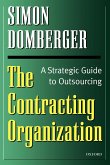- Gebundenes Buch
- Merkliste
- Auf die Merkliste
- Bewerten Bewerten
- Teilen
- Produkt teilen
- Produkterinnerung
- Produkterinnerung
This book is a companion to Health and Safety: Risk Management, which describes techniques and background knowledge for preventing injury and ill health in the workplace. This text instead describes the techniques and background knowledge for preventing impairment of worker well-being and wellness.
Andere Kunden interessierten sich auch für
![Culture by Design Culture by Design]() Hugo MetcalfeCulture by Design206,99 €
Hugo MetcalfeCulture by Design206,99 €![101 Case Studies in Construction Management 101 Case Studies in Construction Management]() Len Holm101 Case Studies in Construction Management206,99 €
Len Holm101 Case Studies in Construction Management206,99 €![Pain Free Dental Deals Pain Free Dental Deals]() William S BarrettPain Free Dental Deals29,99 €
William S BarrettPain Free Dental Deals29,99 €![EEO Law and Personnel Practices EEO Law and Personnel Practices]() Arthur GutmanEEO Law and Personnel Practices202,99 €
Arthur GutmanEEO Law and Personnel Practices202,99 €![The Contracting Organization The Contracting Organization]() Simon DombergerThe Contracting Organization106,99 €
Simon DombergerThe Contracting Organization106,99 €![Fraud and Corruption in Public Services Fraud and Corruption in Public Services]() Peter TicknerFraud and Corruption in Public Services79,99 €
Peter TicknerFraud and Corruption in Public Services79,99 €![Sovereign Debt Sustainability Sovereign Debt Sustainability]() Daniel CashSovereign Debt Sustainability182,99 €
Daniel CashSovereign Debt Sustainability182,99 €-
-
-
This book is a companion to Health and Safety: Risk Management, which describes techniques and background knowledge for preventing injury and ill health in the workplace. This text instead describes the techniques and background knowledge for preventing impairment of worker well-being and wellness.
Hinweis: Dieser Artikel kann nur an eine deutsche Lieferadresse ausgeliefert werden.
Hinweis: Dieser Artikel kann nur an eine deutsche Lieferadresse ausgeliefert werden.
Produktdetails
- Produktdetails
- Verlag: Taylor & Francis
- Seitenzahl: 410
- Erscheinungstermin: 8. August 2024
- Englisch
- Abmessung: 234mm x 156mm x 24mm
- Gewicht: 767g
- ISBN-13: 9781032791104
- ISBN-10: 1032791101
- Artikelnr.: 70148395
- Herstellerkennzeichnung
- Libri GmbH
- Europaallee 1
- 36244 Bad Hersfeld
- gpsr@libri.de
- Verlag: Taylor & Francis
- Seitenzahl: 410
- Erscheinungstermin: 8. August 2024
- Englisch
- Abmessung: 234mm x 156mm x 24mm
- Gewicht: 767g
- ISBN-13: 9781032791104
- ISBN-10: 1032791101
- Artikelnr.: 70148395
- Herstellerkennzeichnung
- Libri GmbH
- Europaallee 1
- 36244 Bad Hersfeld
- gpsr@libri.de
Tony Boyle was a freelance consultant specialising in research and development aspects of health and safety. He has extensive consultancy, lecturing, and training experience in Europe, and has also worked in Hong Kong, Thailand, and the USA. Tony is a Chartered Fellow of IOSH, a Chartered Psychologist, a Registered Occupational Psychologist, and a Certified Risk Professional. He has held various occupational safety and occupational psychology research and lecturing posts. Until 1998, he was the Chairman of the Health and Safety Consultancy, Hastam, and remained a non-executive director of the company until 2022. Fiona Charlton has more than 20 years' experience in operational and strategic health and safety positions. She holds a Masters in Occupational Health and Safety from Queens University, Belfast, and a professional doctorate from Sunderland University that examined the impact of workplace cultures on health and safety management. Fiona continues to work full time in the private sector, is a chartered member of IOSH, and sits on viva panels for doctoral students at Sunderland University.
1.Preliminaries Part 1 - The background information 2. Part 1 overview 3.
The harms 4. The disorders 5. The hazards and risk sources 6. The
elimination and control 7. The triggers 8. The improvers 9. The psychology
10. The people 11. The psychosocial management system terminology 12. The
documented information Part 2 - The practicalities 13. Part 2 overview 14.
What is already in place? 15. Purpose, intended outcomes, scope, policy and
psychosocial objectives 16. Needs and expectations 17. The psychosocial
management system manual 18. SWOT analysis 19. Consultation and
participation 20. Competences 21. Awareness and communication 22.
Psychosocial risk sources 23. Psychosocial threat and opportunity
assessment 24. Psychosocial threat and opportunity management 25.
Psychosocial measurement, analysis and evaluation 26. Psychosocial
monitoring, auditing, nonconformity, correction and corrective action 27.
Psychosocial investigation 28. The role of top management 29. Management
review 30. Psychosocial planning and continual improvement 31. Change,
procurement and emergencies 32. The psychosocial management system
development plan
The harms 4. The disorders 5. The hazards and risk sources 6. The
elimination and control 7. The triggers 8. The improvers 9. The psychology
10. The people 11. The psychosocial management system terminology 12. The
documented information Part 2 - The practicalities 13. Part 2 overview 14.
What is already in place? 15. Purpose, intended outcomes, scope, policy and
psychosocial objectives 16. Needs and expectations 17. The psychosocial
management system manual 18. SWOT analysis 19. Consultation and
participation 20. Competences 21. Awareness and communication 22.
Psychosocial risk sources 23. Psychosocial threat and opportunity
assessment 24. Psychosocial threat and opportunity management 25.
Psychosocial measurement, analysis and evaluation 26. Psychosocial
monitoring, auditing, nonconformity, correction and corrective action 27.
Psychosocial investigation 28. The role of top management 29. Management
review 30. Psychosocial planning and continual improvement 31. Change,
procurement and emergencies 32. The psychosocial management system
development plan
1.Preliminaries Part 1 - The background information 2. Part 1 overview 3.
The harms 4. The disorders 5. The hazards and risk sources 6. The
elimination and control 7. The triggers 8. The improvers 9. The psychology
10. The people 11. The psychosocial management system terminology 12. The
documented information Part 2 - The practicalities 13. Part 2 overview 14.
What is already in place? 15. Purpose, intended outcomes, scope, policy and
psychosocial objectives 16. Needs and expectations 17. The psychosocial
management system manual 18. SWOT analysis 19. Consultation and
participation 20. Competences 21. Awareness and communication 22.
Psychosocial risk sources 23. Psychosocial threat and opportunity
assessment 24. Psychosocial threat and opportunity management 25.
Psychosocial measurement, analysis and evaluation 26. Psychosocial
monitoring, auditing, nonconformity, correction and corrective action 27.
Psychosocial investigation 28. The role of top management 29. Management
review 30. Psychosocial planning and continual improvement 31. Change,
procurement and emergencies 32. The psychosocial management system
development plan
The harms 4. The disorders 5. The hazards and risk sources 6. The
elimination and control 7. The triggers 8. The improvers 9. The psychology
10. The people 11. The psychosocial management system terminology 12. The
documented information Part 2 - The practicalities 13. Part 2 overview 14.
What is already in place? 15. Purpose, intended outcomes, scope, policy and
psychosocial objectives 16. Needs and expectations 17. The psychosocial
management system manual 18. SWOT analysis 19. Consultation and
participation 20. Competences 21. Awareness and communication 22.
Psychosocial risk sources 23. Psychosocial threat and opportunity
assessment 24. Psychosocial threat and opportunity management 25.
Psychosocial measurement, analysis and evaluation 26. Psychosocial
monitoring, auditing, nonconformity, correction and corrective action 27.
Psychosocial investigation 28. The role of top management 29. Management
review 30. Psychosocial planning and continual improvement 31. Change,
procurement and emergencies 32. The psychosocial management system
development plan








